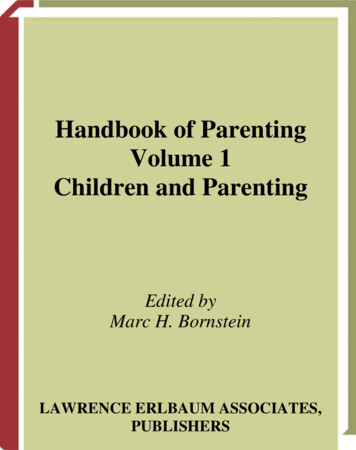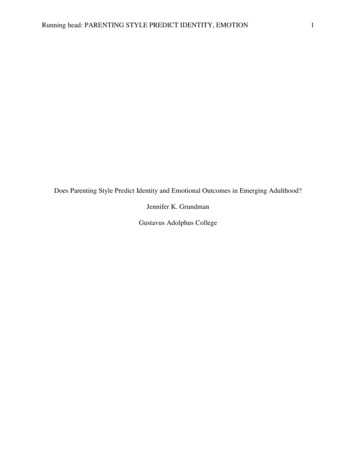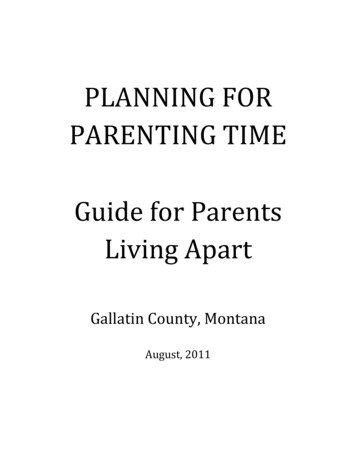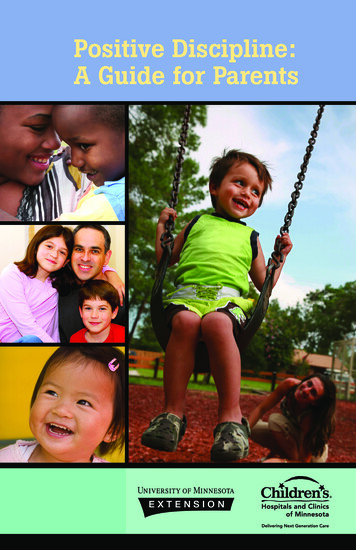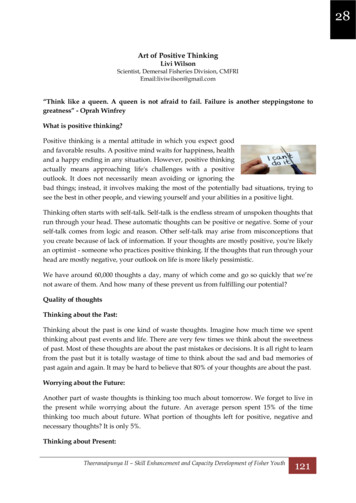
Transcription
Sp ecialI s sueNational Institutes of Health Department of Health and Human Services newsinhealth.nih.govPositive ParentingBuilding Healthy RelationshipsWith Your KidsParents have an important job.Raising kids is both rewarding andchallenging. You’re likely to get alot of advice along the way, fromdoctors, family, friends, and evenstrangers. But every parent andchild is unique. Being sensitiveand responsive to your kids canhelp you build positive, healthyrelationships together.Special IssueHealthyParentingParenting1 PositiveBuilding Healthy RelationshipsWith Your Kids3Shape YourFamily’s HabitsHelping Kids Make HealthyChoices5It’s a Kid’s Job7See, Hear, Speak9Keeping Up in School?11Playing Helps Kids Learnand GrowAre Kids’ Senses Readyfor School?Identifying Learning ProblemsSafeguarding Our HealthVaccines Protect Us All“Being a sensitiveparent and respondingto your kids cuts acrossall areas of parenting,”says Arizona StateUniversity’s Dr. KeithCrnic, a parent-childrelationship expert.“What it means isrecognizing whatyour child needs inthe moment andproviding that in aneffective way.”This can be especiallycritical for infants and toddlers,he adds. Strong emotional bondsoften develop through sensitive,responsive, and consistent parentingin the first years of life. For instance,holding your baby lovingly andresponding to their cries helpsbuild strong bonds.Building BondsStrong emotional bonds helpchildren learn how to managetheir own feelings and behaviorsand develop self-confidence. Theyhelp create a safe base from whichthey can explore, learn, and relateto others.Experts call this type of strongconnection between children andtheir caregivers “secure attachment.”Securely attached children aremore likely to be able to cope withchallenges like poverty, familyinstability, parental stress, anddepression.A recent analysis shows thatabout 6 out of 10 children in theU.S. develop secure attachments totheir parents. The 4 out of 10 kidswho lack such bonds may avoidtheir parents when they are upsetor resist their parents if they causethem more distress. Studies suggestthat this can make kids more proneto serious behavior problems.Researchers have been testingprograms to help parents developbehaviors that encourage secureattachment.Being AvailableModern life is full of things that caninfluence your ability to be sensitiveand responsive to your child. Theseinclude competing priorities, extrawork, lack of sleep, and things likemobile devices. Some experts areconcerned about the effects thatdistracted parenting may have onemotional bonding and children’s
2newsinhealth.nih.gov/special-issueslanguage development, socialinteraction, and safety.If parents are inconsistentlyavailable, kids can get distressed andfeel hurt, rejected, or ignored. Theymay have more emotional outburstsand feel alone. They may even stopIf parents areinconsistently available,kids can get distressedand feel hurt, rejected,or ignored.trying to compete for their parents’attention and start to lose emotionalconnections to their parents.“There are times when kids reallydo need your attention and wantyour recognition,” Crnic explains.Parents need to communicatethat their kids are valuable andimportant, and children need toknow that parents care what they’redoing, he says.It can be tough to respond withsensitivity during tantrums,arguments, or other challengingNIH News in HealthISSN 2375-6993 (Print) ISSN 1556-3898 (Online)Editor Harrison Wein, Ph.D.Managing Editor Tianna Hicklin, Ph.D.Graphics Alan Defibaugh (illustrations),Bryan Ewsichek (design)This special issue is a collection of previouslypublished articles. However, articles wereupdated and re-reviewed by NIH expertsprior to inclusion. Published July 2018.Use our articles and illustrations in your ownpublication. Our material is not copyrighted.Please acknowledge NIH News in Health as thesource and send us a copy.newsinhealth.nih.govNIH Turning Discovery Into Health Office of Communications & Public LiaisonBuilding 31, Room 5B52Bethesda, MD 20892-2094email: nihnewsinhealth@od.nih.govphone: 301-451-8224times with your kids. “If parentsrespond by being irritable oraggressive themselves, children canmimic that behavior, and a negativecycle then continues to escalate,”explains Dr. Carol Metzler, whostudies parenting at the OregonResearch Institute.According to Crnic, kids start toregulate their own emotions andbehavior around age 3. Up untilthen, they depend more on you tohelp them regulate their emotions,whether to calm them or help getthem excited. “They’re watching youto see how you do it and listeningMake some time to spendwith your child that isn’thighly directive, whereyour child leads the play.to how you talk to them about it,”he explains. “Parents need to begood self-regulators. You’re notonly trying to regulate your ownemotions in the moment, but helpingyour child learn to manage theiremotions and behavior.”As kids become better atmanaging their feelings andbehavior, it’s important to help themdevelop coping skills, like activeproblem solving. Such skills can helpthem feel confident in handling whatcomes their way.“When parents engage positivelywith their children, teaching themthe behaviors and skills that theyneed to cope with the world, childrenlearn to follow rules and regulatetheir own feelings,” Metzler says.“As parents, we try really hard toprotect our kids from the experienceof bad things,” Crnic explains. “Butif you protect them all the time andthey are not in situations wherethey deal with difficult or adversecircumstances, they aren’t able todevelop healthy coping skills.”He encourages you to allowyour kids to have more of thoseexperiences and then help themlearn how to solve the problemsthat emerge. Talk through thesituation and their feelings. Thenwork with them to find solutionsto put into practice.Meeting NeedsAs children grow up, it’s importantto remember that giving them whatthey need doesn’t mean giving themeverything they want. “These twothings are very different,” Crnicexplains. “Really hone in on exactlywhat’s going on with your kid inthe moment. This is an incrediblyimportant parenting skill and it’slinked to so many great outcomesfor kids.”Think about where a child is in lifeand what skills they need to learn atthat time. Perhaps they need helpmanaging emotions, learning howto behave in a certain situation,thinking through a new task, orrelating to friends.“You want to help kids becomeconfident,” Crnic says. “You don’twant to aim too high where theycan’t get there or too low wherethey have already mastered theskill.” Another way to boostconfidence while strengthening yourrelationship is to let your kid takethe lead.“Make some time to spend withyour child that isn’t highly directive,where your child leads the play,”advises Dr. John Bates, who studieschildren’s behavior problems atIndiana University Bloomington.“Kids come to expect it and theylove it, and it really improves therelationship.”Bates also encourages parents tofocus on their child’s actual needsinstead of sticking to any specificparenting principles.It’s never too late to startbuilding a healthier, more positiverelationship with your child, evenif things have gotten strained andstressful. “Most importantly, makesure that your child knows that youlove them and are on their side,”Metzler says. “For older children,
3newsinhealth.nih.gov/special-issueslet them know that you are genuinelycommitted to building a strongerrelationship with them and helpingthem be successful.”By being a sensitive andresponsive parent, you can helpset your kids on a positive path,teach them self-control, reduce thelikelihood of troublesome behaviors,and build a warm, caring parentchild relationship.Wise ChoicesTips for Connectingwith Your KidsCatch kids showing good behaviorand offer specific praise.Give children meaningful jobs athome and positive recognitionafterward. Don’t be overly critical;instead, help them improve theirskills one step at a time.Use kind words, tones, and gestures when giving instructions ormaking requests.Spend some time every day inwarm, positive, loving interactionwith your kids. Look for opportunities to spend time as a family,like taking after-dinner walks orreading books together.Brainstorm solutions to problemsat home or school together.Set rules for yourself for mobiledevice use and other distractions.For instance, check your phoneafter your child goesto bed.Ask about your child’s concerns,worries, goals, and ideas.Participate in activities that yourchild enjoys. Help out with and attend their events, games, activities,and performances.Web LinksFor more about positive parenting,go to: ive-parentingShape Your Family’s HabitsHelping Kids Make Healthy ChoicesMany things can influencea child, including friends,teachers, and the thingsthey see when they sit infront of the TV or computer.If you’re a parent, knowthat your everyday behaviorplays a big part in shapingyour child’s behavior, too.With your help, kids canlearn to develop healthyeating and physical activityhabits that last throughouttheir lives.Healthy eating andphysical activity areessential for children of anyage. “They can have manyhealth benefits for children,including promoting hearthealth and improving mood,” saysDr. Voula Osganian, a child obesityspecialist at NIH.Getting active and eating rightmay also prevent excess weightand childhood obesity, a growingconcern in this country. Today,nearly 1 in 3 children in the UnitedStates is overweight or obese. “Ifsomeone develops obesity as a childor adolescent, there’s a very highlikelihood that they’ll remain obeseor overweight as an adult,” Osganianexplains. “But studies also show thatif you start eating healthy and beingactive early, you tend to maintainthose habits over time.”Although most of us know that it’sa good idea to eat healthy food andmove more, it isn’t always easy to do.Children aren’t likely to change theirdiet and activity habits on their own.It’s up to you to make it easier foryour family to make healthy choices.“Parents are very important interms of arranging an environmentand setting a model for healthyor unhealthy behavior,” saysDr. Leonard H. Epstein, an experton childhood obesity at theUniversity of Buffalo. “Parentsbring foods into the house. Theycontrol how much time a childcan watch TV. They control whatkinds of social activities are pairedwith foods. And kids learn a hugeamount about eating and physicalactivity from watchingand imitating their parents.”Epstein’s research showshow important parents can be.In NIH-funded work, his teamassigned obese children, ages 8to 12, to different types of weightloss programs. All the groupswere taught about healthy diet,behaviors, and exercise. For somegroups, positive feedback andencouragement for weight lossand behavior changes were givenonly to the child. Other groupsfocused on both the child and anobese parent. Comparison groupsreceived little feedback.The researchers found that whenobese parents and children workedtogether, both were more successfulat losing weight and making healthychanges. “Our studies suggest thatgetting the whole family workingtogether really benefits the child,”Epstein says. “Even after 10 years,when these kids were 18 to 22
4newsinhealth.nih.gov/special-issuesyears old, the ones who had theparent working with them had lostmore weight and maintained moreweight loss than the ones treated bythemselves, and obviously more thanthe comparison groups.”Over time, most parents graduallybegan to regain their lost weight,the researchers found. But after 10years, more than 40% of the kidswho worked with their parents hadmaintained a weight reduction of atleast 20%. “The finding suggests thateven if the parents go back to theirold behaviors, many of the kids willnot,” says Epstein.While it’s never too late to startmaking healthy changes in yourfamily, research suggests that theearlier your kids learn healthybehaviors, the better.Wise ChoicesHelp Kids FormHealthy HabitsBe a role model. Eat healthy familymeals together. Walk or ride bikesinstead of watching TV or surfingthe Web.Make healthy choices easy. Putnutritious food where it’s easy tosee. Keep balls and other sportsgear handy.Focus on fun. Play in the park,or walk through the zoo or on anature trail. Cook a healthy mealtogether.Limit screen time. Don’t put a TVin your child’s bedroom. Avoidsnacks and meals in front ofthe TV.Check with caregivers or schools.Make sure they offer healthyfoods, active playtime, and limitedTV or video games.Change a little at a time.If you drink whole milk, switchto 2% milk for a while, then tryeven lower fat milks. If you driveeverywhere, try walking to anearby friend’s house, then latertry walking a little farther.Dr. Julie Lumeng, a pediatrician atthe University of Michigan, focusesher NIH-funded research on thefactors that affect eating behaviorsin young children—especiallypreschoolers and infants. That’s anideal time to start exposing yourchildren to a variety of healthyfoods, such as fruits and vegetables,so they develop a liking for them.Getting young ones to acceptfruits and vegetables can be achallenge, but some parents give uptoo quickly if a child rejects a newfood. Research suggests that themore times you offer a food, the morelikely a child will be to warm up to it.“Kids typically have to taste a newfood 9 to 15 times to begin to like it,”Lumeng says.If your child doesn’t like a newfood right away, stay positive andkeep trying over time. Encouragingkids to take just one bite of a newfood can help. But avoid creatingconflicts and stress over it. “Tryinga new food can be exciting and alsostressful in general,” Lumeng says.“Several studies show that kidsare more likely to try a new foodif they’re eating in a setting that’srelaxing and pleasant.”Children under the age of threetend to stop eating on their ownwhen they’re full. “But after agethree,” Lumeng says, “the more youput on their plate, the more they’lleat.” So make sure to give your kidschild-size portions.Take opportunities to teachyoung children about feelings offullness. “If your child asks foranother helping, instead of saying,‘No, honey, you’ve had enough,’ trysaying something like, ‘You mustreally be hungry tonight,’ to raisetheir awareness of their feelings,”Lumeng suggests. “Or when theystop eating, say, ‘Oh, you must feelfull now,’ to help teach about hungerand feeling satisfied.”Several studies show that parentscan effectively influence healthybehaviors by talking in a positiveway or avoiding certain situationsGetting young onesto accept fruits andvegetables can be achallenge, but someparents give up tooquickly if a child rejectsa new food.altogether. “Instead of telling yourchildren, ‘No, you can’t have anymore cookies,’ just keep cookiesout of the house altogether,” saysLumeng.When you bring unhealthy foodand sugary drinks into the house,“parents essentially become the foodpolice,” adds Epstein. “It’s easier tocreate an environment in the homewhere there’s limited access tounhealthy foods and lots of access tohealthy foods.”Experts recommend that mostkids get at least an hour of moderateto vigorous physical activity eachday. Parents can help by limiting TVand computer time to no more thanone or two hours per day.“Small changes in the homeenvironment can also have a hugeeffect on physical activity,” saysEpstein. You can make sportsequipment like balls and jumpropes more accessible by puttingthem next to the door. Walking fast,bicycling, jumping rope, and playingbasketball, soccer, or hopscotch areall good ways for kids to be active.When it comes to food andphysical activity, what you say anddo around your children can havea lasting effect. Work together as afamily to make healthy habits easyand fun.Web LinksFor more about healthy eating andphysical activity, go hape-your-familys-habits
newsinhealth.nih.gov/special-issues5It’s a Kid’s JobPlaying Helps Kids Learn and GrowWhat would childhood be withouttime to play? Play, it turns out, isessential to growing up healthy.Research shows that active, creativeplay benefits just about every aspectof child development.Play can help lay afoundation for learning theskills we need for socialinteractions.“Play is behavior that looks asif it has no purpose,” says NIHpsychologist Dr. Stephen Suomi.“It looks like fun, but it actuallyprepares [kids] for a complexsocial world.” Evidence suggeststhat play can help boost brainfunction, increase fitness, improvecoordination, and teach cooperation.Suomi notes that all mammals—from mice to humans—engage insome sort of play. His researchfocuses on rhesus monkeys. Whilehe’s cautious about drawing parallelsbetween monkeys and people, hisstudies offer some general insightsinto the benefits of play.Active, vigorous social play duringdevelopment helps to sculpt themonkey brain. The brain growslarger. Connections between brainareas may strengthen. Play alsohelps monkey youngsters learn howto fit into their social group, whichmay range from 30 to 200 monkeysin 3 or 4 extended families.Both monkeys and humans livein highly complex social structures,Suomi says. “Through play, rhesusmonkeys learn to negotiate, to dealwith strangers, to lose gracefully,to stop before things get out ofhand, and to follow rules,” he says.These lessons prepare monkeyyoungsters for life after they leavetheir mothers.Play may have similar effects inthe human brain. Play can help laya foundation for learning the skillswe need for social interactions. Ifhuman youngsters lack playtime,says Dr. Roberta Golinkoff, an infantlanguage expert at the University ofDelaware, “social skills will likelysuffer. You will lack the ability toinhibit impulses, to switch taskseasily, and to play on your own.”Play helps young children mastertheir emotions and make their owndecisions. It also teaches flexibility,motivation, and confidence.Kids don’t need expensive toys toget a lot out of playtime. “Parentsare children’s most enriching plaything,” says Golinkoff. Playing andtalking to babies and children arevital for their language development.Golinkoff says that kids who talkwith their parents tend to acquire avocabulary that will later help themin school. Let kids guide the conversation. When you take over theconversation, you may shut it down.Unstructured, creative, physicalplay also lets children burn caloriesand develop all kinds of strengths,such as learning how the worldworks. In free play, children choosethe games, make the rules, learnto negotiate, and release stress.Free play often involves fantasy. Ifchildren, say, want to learn aboutbeing a fireman, they can imaginePlay helps young childrenmaster their emotionsand make their owndecisions. It also teachesflexibility, motivation, andconfidence.and act out what a fireman does. Andif something scary happens, freeplay can help defuse emotions byworking them out.“Sports are a kind of play,”Golinkoff says, “but it’s not the kids
6newsinhealth.nih.gov/special-issuescalling the shots.” It’s importantto engage in a variety of activities,including physical play, social play,and solitary play. “The key is thatin free play, kids are making theAs media screens drawkids indoors, hours ofsitting raise the riskfor obesity and relateddiseases.decisions,” says Golinkoff. You can’tlearn to make decisions if you’realways told what to do.Some experts fear that free playis becoming endangered. In the lasttwo decades, children have lost anaverage of eight hours of free play perweek. As media screens draw kidsindoors, hours of sitting raise therisk for obesity and related diseases.When it comes to video games andother media, parents should monitorcontent, especially violent content,and limit the amount of timechildren sit.There’s also been a nationaltrend toward eliminating schoolrecess. “Thousands of children havelost recess altogether,” says childdevelopment expert Dr. KathrynWise ChoicesPlay To Learnand GrowKids don’t need expensivetoys and games to engage inenriching play.Let children lead.Monitor screen time (computer,TV, video games). Encouragemore active play.Get involved with yourcommunity to make playtimeand play space available for allchildren.Hirsh-Pasek of Temple University.“Lack of recess has importantconsequences for young childrenwho concentrate better when theycome inside after a break from theschoolwork.”Many kids, especially those inlow-income areas, lack access tosafe places to play. This makestheir school recess time evenmore precious. In response tothese changes, some educatorsare now insisting that preschooland elementary school childrenhave regular periods of active, freeplay with other children. The typeof learning that happens duringplaytime is not always possible inthe classroom. School recess is alsoOlder children, including teens, alsoneed to play and daydream, whichhelps their problem-solving andcreative imagination. Adults, too,need their breaks, physical activity,and social interaction.Play can also be important formedical care. At the NIH ClinicalCenter in Bethesda, Maryland,Unstructured, creative,physical play letschildren burn caloriesand develops all kindsof strengths, such aslearning how the worldworks.“Recreation therapy services areseen as essential to the patients’recovery,” says Donna Gregory, chiefof recreational therapy. She andher team tailor activities for bothchildren and adults. Games canget patients moving, even for justminutes at a time, which improvestheir functioning.Medical play helps children copewith invasive procedures. A 2-yearold can be distracted with blowingbubbles; older kids can place theirteddy bear in the MRI machine orgive their doll a shot before theythemselves get an injection. It giveskids a sense of control and supportstheir understanding in an ageappropriate, meaningful way.Without play and recreation,people can become isolated anddepressed. “There’s therapeuticvalue in helping patients maintainwhat’s important to them,” saysGregory. “When you are physicallyand socially active, it gives lifemeaning.”important because of the growingnumber of obese children in theUnited States. Running aroundduring recess can help kids stayat a healthy weight.Play also may offer advantageswithin the classroom. In anNIH-funded study, Hirsh-Pasek,Golinkoff, and their colleaguesfound a link between preschoolers’math skills and their ability tocopy models of two- and threedimensional building-blockconstructions. Play with buildingblocks—and block play alongsideadults—can help build children’sspatial skills so they can get anearly start toward the later study ofscience, technology, engineering,or math.“In a way, a child is becoming ayoung scientist, checking out howthe world works,” says Hirsh-Pasek.”We never outgrow our need to play.”Older children, includingteens, also need to playand daydream, whichhelps their problemsolving and creativeimagination.Web LinksFor more about play,go to: kids-job
newsinhealth.nih.gov/special-issues7See, Hear, SpeakAre Kids’ Senses Ready for School?When setting off for kindergartenor first grade, a child may feel prepared with a backpack loaded withcrayons, pencils, and paper. But agood start in the classroom dependson more than just school supplies.Healthy hearing, vision, speech,and language are key to success atschool. If a child has problems inthese areas, the sooner they’re spotted, the better they can be treated.A good start in theclassroom depends onmore than just schoolsupplies. Healthy hearing,vision, speech, andlanguage are key tosuccess at school.Sometimes problems with senses,speech, or language fly under theradar. A child with a lazy eye or a little hearing loss might get along justfine at home or in daycare. But whenchildren get to school, minor difficulties may start to catch up withthem. They may have trouble focusing and flourishing in the classroom.NIH-funded scientists are searchingfor better ways to recognize andtreat these types of problems as earlyas possible.Nearly all newborns are screenedfor hearing loss before leaving thehospital. For newborns diagnosedwith hearing loss, interventionssuch as hearing aids or cochlearimplants should begin no later than6 months of age. When interventionsbegin early, children with hearingloss can develop language skills thathelp them communicate.Hearing problems can also arisein older kids. “Some children areborn with normal hearing and develop hearing loss later for variousreasons,” says Dr. Mary Pat Moeller,who studies childhood deafnessand language development at BoysTown National Research Hospitalin Nebraska. Head injuries, meningitis, and chronic fluid behind theeardrum from repeated bouts of earinfections are just a few conditions that can lead to laterhearing loss.“We rely on normal hearing to pick up concepts andlearn new words,” Moellersays. But a noisy classroom can be tough forkids who can’t hear well.“Children with undetectedhearing loss may look likethey have attention deficits.They may miss what they’vebeen told because they’re just nothearing clearly,” she says.Screening for hearing loss inschool-age kids is a familiar process. Children wear headphonesand raise their hands as they heara series of tones. Some 5% to 10% ofschool-age children don’t pass thesetests. Kids with hearing loss can befitted with hearing aids or benefitfrom cochlear implants or assistivedevices. For example, teachers canwear microphones that send theirvoices directly to the children’s ears.Even children with minimal hearingloss can benefit from this type oftechnology.Children learn language by listening to others and engaging in conversations. But kids with hearing losscan miss out on some of this experience. Moeller and her colleagues arestudying how children with hearingloss develop language. Results fromthis NIH-funded research point toseveral factors that can help. Theseinclude the quality and fit of hearingaids, how often kids get speech andlanguage training, and how oftenparents have conversations withtheir children.A different source of languageproblems is a disorder calledChildren learn languageby listening to othersand engaging inconversations. But kidswith hearing loss canmiss out on some of thisexperience.specific language impairment, ordevelopmental language disorder.This condition affects an estimated7% of children in kindergarten. Kidswith specific language impairmenthave trouble learning new wordsand engaging in conversation. Theymight produce grammaticallyincorrect sentences like “What hewant for dinner?” or they might havea small vocabulary.“Both of those are fundamentalto being able to communicate withthe teacher, to understanding whatthe teacher is saying to them, and toforming social relationships withtheir peers,” says Dr. Mabel Rice, anNIH-funded researcher who studies
8newsinhealth.nih.gov/special-issueschildhood language disorders at theUniversity of Kansas.For example, a child with specificlanguage impairment might not un-Vision problems arecommon in preschoolers,but kids don’t alwaystell others about theirsymptoms.derstand that “It’s time to put yourthings away now” means “Put yourthings away.” Children who don’tunderstand complicated sentencescan seem like they’re disobedient,Rice says. More complicated grammar is also good for making friends.Saying “I would like it if you’d comeplay with me” might attract moreplaymates than “Come over here.”Wise ChoicesSigns of Eye, Ear, orLanguage ProblemsTalk with a health care provider ifyour child:doesn’t respond consistently tosounds or to his or her name.asks for things to be repeated orsays “huh?” a lot.turns the volume up on the TVand other electronic devices.speaks unclearly.has trouble following spokendirections.leaves words out of sentenceswhen talking.uses tenses (past, present, andfuture) improperly.has trouble catching balls orseeing distant objects.has eyes that cross or pointoutward.avoids close work or holds booksunusually close when reading.complains of eye discomfort,headaches, or blurred vision.In the past, parents were sometimes blamed for a child’s languagedisability. They might have beenfaulted for not reading enough totheir children. But research suggeststhat specific language impairmenthas other roots. The disorder tendsto run in families, which hints thatgenes play a role. Rice led a study ofover 300 people, including childrenwith specific language impairmentand their families. The scientistsidentified a gene that’s also linked todyslexia and other learning disabilities. The finding might eventuallylead to better understanding andtreatment of these disorders.Kids don’t usually grow out ofspecific language impairment. Theirlanguage improves, but they cancontinue to struggle with subtletieseven after they enter the workforce.“It is very important to identify thesekids, particularly at school entry orbefore school entry,” Rice says. Manyschool districts screen children forspecific language impairment beforekindergarten. Language therapy canhelp children catch up.Poor vision can also cause troublein school, and the problems maygo unnoticed. Vision problems arecommon in preschoolers, but kidsdon’t always tell others about theirsymptoms. Children might eventhink it’s normal to see double orfor things to be blurry. But pooreyesight can cause headaches andhinder reading. Some children withvision problems might seem to haveattention difficulties, since eyestrainand headaches can make it hard tostay on task.The most common cause of visionimpairment in children is amblyopia, or lazy eye. It often arises if theeyes point in different directions, orif one eye produces a better imagethan the other. The brain starts toshut down signals from the weakereye. Treatment encourages use of theweaker eye, sometimes by putting apatch over the other eye. NIH-funded research has found that treatmentfor amblyopia is more effective ifbegun when a child is young.So
kinds of social activities are paired with foods. And kids learn a huge amount about eating and physical activity from watching and imitating their parents.” Epstein’s research shows how important parents can be. In NIH-funded work, his team assigned obese children, ages 8 to 12, t

